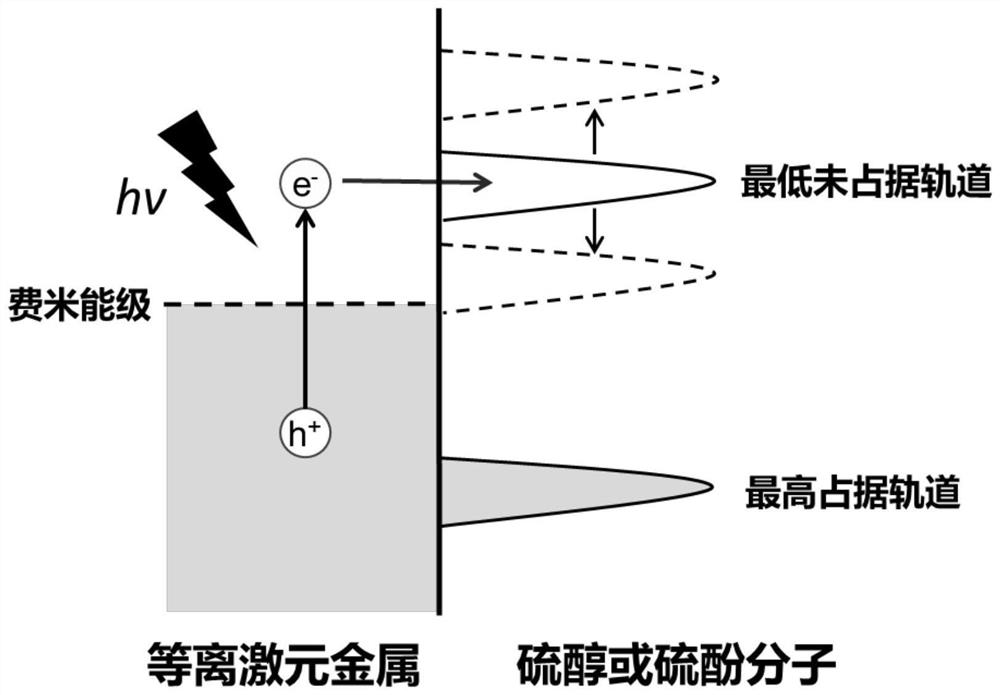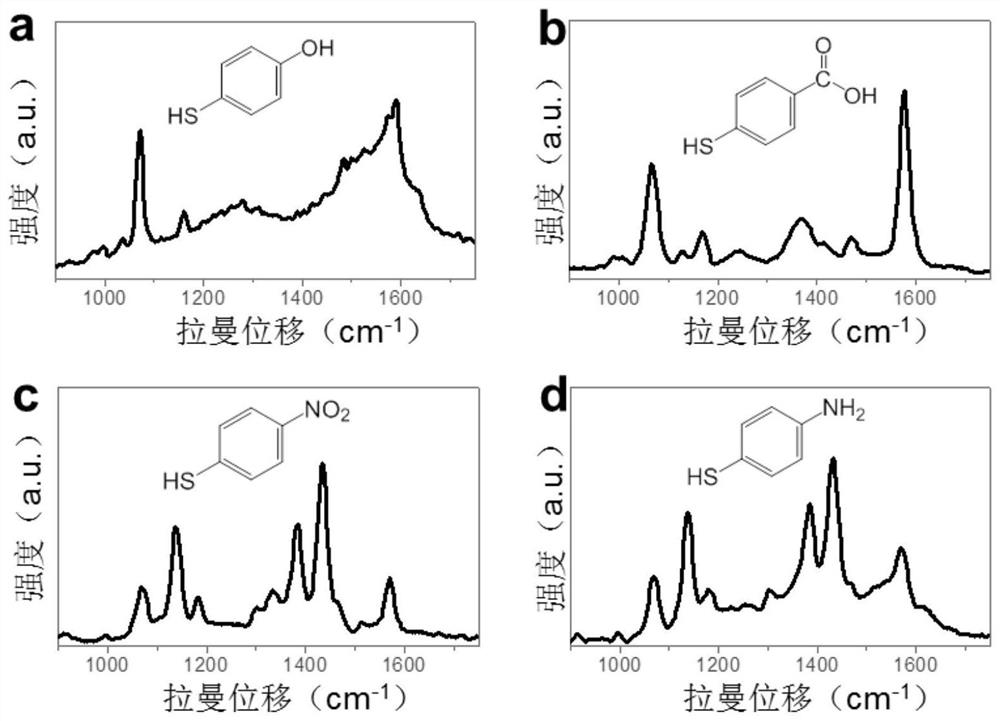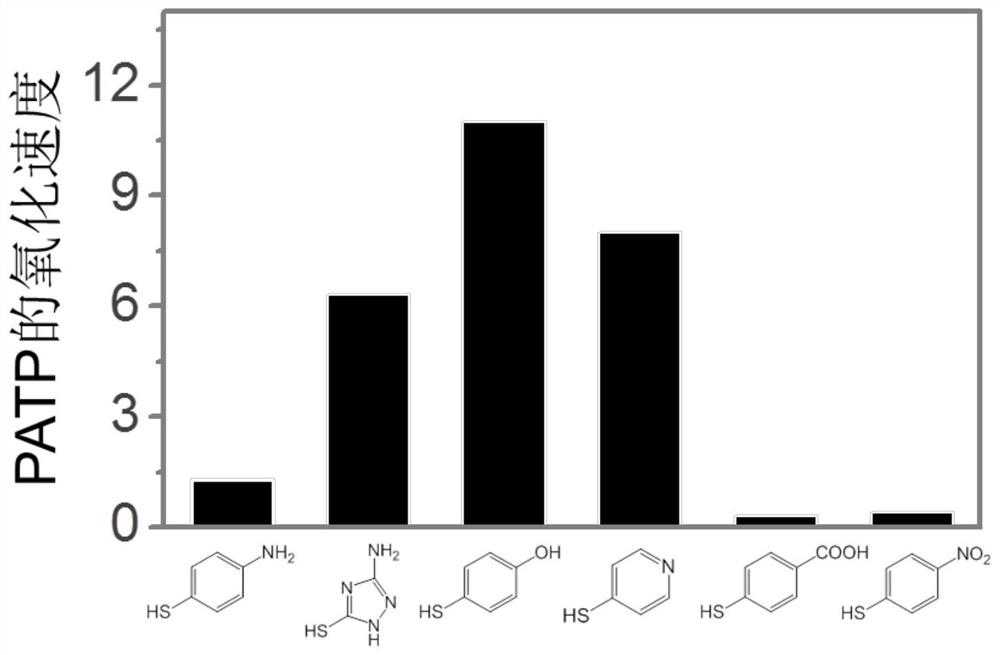Method for regulating and controlling surface plasmon photocatalysis and application
A plasmonic and photocatalytic technology applied in the field of photocatalysis to achieve the effect of promoting efficiency
- Summary
- Abstract
- Description
- Claims
- Application Information
AI Technical Summary
Problems solved by technology
Method used
Image
Examples
Embodiment 1
[0027] Example 1: Method principle of different thiol or thiophenol molecules regulating the hot carrier-driven photocatalytic reaction generated by surface plasmons
[0028] figure 1 It is a schematic diagram of the separation behavior of hot carriers in the process of photocatalytic reaction driven by hot carriers generated by different thiol or thiophenol molecules. In the figure, the transfer behavior of hot electrons is taken as an example;
[0029] Table 1 shows the LUMO and HOMO energy levels of some common thiols and thiophenols;
[0030]
[0031] Organic molecules contain the highest occupied molecular orbital (HOMO) and the lowest unoccupied molecular orbital (LUMO), which can be compared to the valence and conduction bands in semiconductors. Similar to metal-semiconductor heterostructures, when molecules are adsorbed on the surface of plasmonic metals, if the energy of excited hot electrons (or hot holes) can be matched with the energy level of LUMO (or HOMO), t...
Embodiment 2
[0032] Embodiment 2: Modification method of thiol or thiophenol molecules
[0033] Under the strong chemical bond between thiol and metal, thiol and thiophenol molecules can be chemisorbed on the surface of plasmonic metal. The specific operation process is as follows:
[0034] Dissolve an appropriate amount of thiol or thiophenol molecules in ethanol, add them to the prepared plasmonic metal nanostructure solution or substrate, mix for about one hour, and a uniform and densely distributed self-assembled molecular layer can be formed on the metal surface . Afterwards, the sample can be washed with ethanol. Such as figure 2 as shown, figure 2 is the Raman signal map of thiophenol molecules adsorbed on silver nanowires, indicating that the molecules are successfully adsorbed on the surface of plasmonic metals; the signals of thiophenol molecules adsorbed on silver nanowires are detected by Raman spectroscopy, indicating successful adsorption of the molecule.
Embodiment 3
[0035] Example 3: Thiol and thiophenol molecules regulate the oxidation reaction of p-aminothiophenol mediated by plasmons
[0036] Silver nanoparticles were used as surface plasmon photocatalysts to catalyze the oxidation of p-aminothiophenol (PATP) to p-mercaptoazobenzene (DMAB). Taking no molecular modification on silver nanoparticles as a blank group, the effects of different thiol and thiophenol molecules on the oxidation process of PATP were quantitatively studied. Among them, the PATP oxidation rate of the blank group was set as 1, and the oxidation rate diagram of PATP after adsorbing different thiol and thiophenol molecules was drawn, image 3 It is the result that different thiols and thiophenols regulate the plasmon-mediated oxidation of p-aminothiophenol. Changing the type of substituents of thiophenol molecules and changing the type of modified molecules can significantly affect the oxidation reaction process of p-aminothiophenol.
[0037] The result is as ima...
PUM
 Login to View More
Login to View More Abstract
Description
Claims
Application Information
 Login to View More
Login to View More - R&D
- Intellectual Property
- Life Sciences
- Materials
- Tech Scout
- Unparalleled Data Quality
- Higher Quality Content
- 60% Fewer Hallucinations
Browse by: Latest US Patents, China's latest patents, Technical Efficacy Thesaurus, Application Domain, Technology Topic, Popular Technical Reports.
© 2025 PatSnap. All rights reserved.Legal|Privacy policy|Modern Slavery Act Transparency Statement|Sitemap|About US| Contact US: help@patsnap.com



